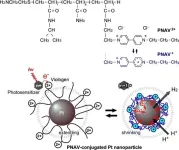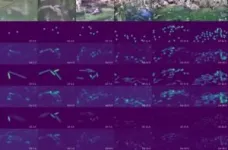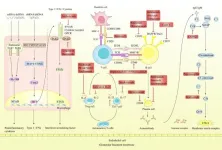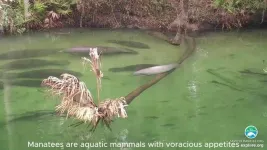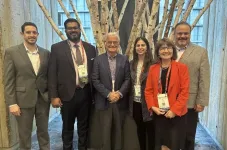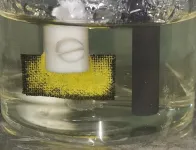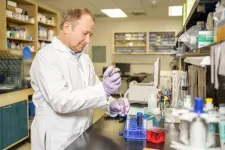(Press-News.org) Ishikawa, Japan -- Various molecular systems have been developed by researchers for photoinduced (i.e., light-driven) electron transfer, including supramolecules, hybrid materials, and organic polymeric systems. While these systems fulfill the distance criterion required by the electron donor and acceptor for efficient electron transfer, they frequently fall short in accommodating molecular motion, especially in fluid environments. Is there a viable approach to design a system that facilitates electron transfer without succumbing to these limitations?
This issue has been specifically addressed in a recent study. A team of researchers from the Japan Advanced Institute of Science and Technology (JAIST), led by Associate Professor Kosuke Okeyoshi and including Associate Professor Shun Nishimura and Graduate course Student Reina Hagiwara, has now developed a copolymer-conjugated nanocatalytic system to enhance active electron transfer for increased photoinduced hydrogen generation.
Their study, published in Chemical Communications, aims to overcome the limitations of current photoinduced electron transfer systems. The objective of the researchers was to establish an efficient catalyst system capable of promoting electron transfer with only a minimum number of side reactions. Dr. Okeyoshi explains: “This system has potential real-life applications for the hydrogen economy. By integrating the system with an oxygen-generating system, photoinduced water splitting (artificial photosynthesis) is anticipated.”
In this regard, viologen is a well-known molecule that is both an efficient electron donor and acceptor. The researchers had previously exploited this property of viologen to develop an electron transfer system, which included the copolymer poly(N-isopropylacrylamide-co-Viologen) (PNV) and modified platinum nanoparticles (Pt NPs). In this system, the temperature-dependent phase transition in PNV responds to viologen's redox changes, allowing for a cyclical electron transfer process for continuous hydrogen generation. However, while the PNVs near the Pt NPs participated in the electron transfer process, free PNV molecules situated farther away could also accept electrons.
To address this issue, the researchers have now designed a copolymer-conjugated nanocatalytic system using the ternary random copolymer poly(NIPAAm-co-Acrylamide-co-Viologen) or PNAV, which was synthesized by precisely controlling the molecular weight and introduction ratio of the polymeric units.
A notable characteristic of PNAV is its temperature-responsive behavior, marked by a phase transition dependent on temperature. This unique copolymer exhibits a discernible shift, oscillating between a swollen state in its oxidized form (PNAV2+) and a shrunken state in its reduced form (PNAV+). Additionally, the connection of PNAV to Pt NPs involves a reduction process, providing control over the distance between the viologen and the Pt NPs. Specifically, the precise swelling/shrinking of PNAV on the Pt NPs proves crucial to the success of the proposed cyclic electron transfer process at a given distance.
The present innovation leverages the advantages of a stimuli-responsive polymer chain to achieve dynamic electron transfer. The copolymer-conjugated nanocatalytic system not only holds promise for facilitating active electron transfer in photoinduced hydrogen generation but also demonstrates potential utility in artificial photosynthetic reactions, such as photoinduced water splitting. Moreover, this innovative approach is anticipated to have broader applications beyond photochemical reactions to encompass various domains, including electrochemical reactions and macromolecular recognition.
The sustainable cyclic electron transfer process enabled by this technology thus presents opportunities for advancements across diverse scientific disciplines. “The long-term implications include the promotion of a hydrogen energy society powered by sunlight and the manufacturing of bio-inspired soft materials as products,” concludes Dr. Okeyoshi.
###
Reference
Title of original paper:
Precise design of copolymer-conjugated nanocatalysts for active electron transfer
Authors:
Reina Hagiwara, Shun Nishimura, Kosuke Okeyoshi*
Journal:
Chemical Communications
DOI:
10.1039/d3cc05242g
About Japan Advanced Institute of Science and Technology, Japan
Founded in 1990 in Ishikawa prefecture, the Japan Advanced Institute of Science and Technology (JAIST) was the first independent national graduate school in Japan. Now, after 30 years of steady progress, JAIST has become one of Japan’s top-ranking universities. JAIST counts with multiple satellite campuses and strives to foster capable leaders with a state-of-the-art education system where diversity is key; about 40% of its alumni are international students. The university has a unique style of graduate education based on a carefully designed coursework-oriented curriculum to ensure that its students have a solid foundation on which to carry out cutting-edge research. JAIST also works closely both with local and overseas communities by promoting industry–academia collaborative research.
About Associate Professor Kosuke Okeyoshi from Japan Advanced Institute of Science and Technology, Japan
Dr. Kosuke Okeyoshi is an associate professor at Japan Advanced Institute of Science and Technology. He holds a Ph.D. from The University of Tokyo (2010), and his research spans photochemistry, polymer chemistry, and soft matter. With over 550 citations, Dr. Okeyoshi has earned numerous accolades, such as The Young Scientists’ Award of the Commendation for Science and Technology by the Minister of Education, Culture, Sports, Science and Technology in 2021, the Award for Encouragement of Research in Polymer Science by The Society for Polymer Science Japan in 2019, and the Young Scientists Presentation Award (SPSJ - Kansai) in 2018.
Funding information
This study was supported by a Grant-in-Aid for Challenging Research (Exploratory) (Grant number: JP21K18998) from The Ministry of Education, Culture, Sports, Science and Technology (MEXT).
END
WASHINGTON, DC, Dec. 13, 2023 – Wildfires pose an increasing threat to communities at the wildland-urban interface (WUI) – where dry, flammable vegetation borders back yards, often in remote locations. Despite the well-known danger, many communities at highest risk do not have a strong wildfire evacuation plan in place. (One of these was the town of Lahaina on Maui, where wind-driven wildfires killed nearly 100 people in August 2023.)
Researchers from UCLA’s John Garrick Institute for the Risk Sciences have built a new web-based software platform that allows emergency planners to design custom-made evacuation plans for their communities ...
Patients with lupus nephritis (LN), a severe complication of systemic lupus erythematosus (SLE), often undergo progressive kidney damage, with approximately 20% of these patients advancing to end-stage renal disease. The current therapeutic landscape for LN, dominated by glucocorticoids and immunosuppressants, is limited by suboptimal response rates, the risk of disease flare-ups and adverse effects, accentuating the necessity for safer and more effective treatment modalities. In the latest issue of the Chinese Medical Journal (CMJ) published online on December 15, 2023, a review authored by Dr. Wei Chen from the Department of Nephrology of the First Affiliated ...
San Francisco and New York — Dec. 13, 2023 — The Parker Institute for Cancer Immunotherapy (PICI), the largest concentration of immuno-oncology (IO) expertise in the world, announced it has added Weill Cornell Medicine to its network of preeminent academic and medical research institutions at the forefront of the fight against cancer. Under the agreement, Weill Cornell Medicine, with new PICI Network researchers, will establish a PICI immuno-oncology research center in New York City.
Since its inception, PICI has distributed $260 million to member researchers to support ...
Manatees are endangered species volatile to the environment. Because of their voracious appetites, they often spend up to eight hours a day grazing for food within shallow waters, making them vulnerable to environmental changes and other risks.
Accurately counting manatee aggregations within a region is not only biologically meaningful in observing their habit, but also crucial for designing safety rules for boaters and divers as well as scheduling nursing, intervention, and other plans. Nevertheless, counting manatees ...
DETROIT (December 13, 2023) – Published results of a large, national heart attack study show that patients with a life-threatening complication known as cardiogenic shock survived at a significantly higher rate when treated with a protocol developed by cardiologists at Henry Ford Health, in collaboration with 80 hospitals nationwide.
Cardiogenic shock is a critical condition in which the heart is unable to pump enough blood to sustain the body’s needs, depriving vital organs of blood supply. This can cause those organs to eventually stop functioning. The typical survival rate of this deadly complication during a heart ...
Researchers from Northwestern University, University of Pennsylvania, and University of Colorado published a new Journal of Marketing study that proposes abandoning null hypothesis significance testing (NHST) as the default approach to statistical analysis and reporting.
The study, forthcoming in the Journal of Marketing, is titled “‘Statistical Significance’ and Statistical Reporting: Moving Beyond Binary” and is authored by Blakeley B. McShane, ...
Oceans cover most of Earth’s surface and support a staggering number of lifeforms, but they’re also home to a dilute population of uranium ions. And — if we can get these particular ions out of the water — they could be a sustainable fuel source to generate nuclear power. Researchers publishing in ACS Central Science have now developed a material to use with electrochemical extraction that attracts hard-to-get uranium ions from seawater more efficiently than existing methods.
Nuclear power reactors release ...
The vast majority of older adults – 83% -- think health insurers should cover medications that can help people with obesity manage their weight, a new poll of people age 50 to 80 finds.
Nearly as many -- 76% -- believe Medicare should cover these drugs, which it cannot currently do under law, according to the new results from the University of Michigan National Poll on Healthy Aging.
A law passed in 2003 prohibits Medicare from covering weight loss medications, though it can cover drugs to help people with Type 2 diabetes manage their weight. Medicaid covers obesity medications ...
With an estimated 1.9 million new cases and more than 600,000 deaths each year, cancer remains the second most common cause of death in the U.S., trailing only heart disease. And while there are more than 200 types of cancer, the abnormal synthesis of a protein known as STAT3 is unique to the majority of tumors.
STAT3 is known as a transcriptional regulator, which means it regulates the expression of several genes. In fact, STAT3 is associated with approximately 70% of all human tumors and is responsible for uncontrolled cell growth and disease progression.
To investigate new approaches to inhibit STAT3 and develop new cancer treatments, the National Institutes of Health-National ...
Flat-faced dog breeds are popular all over the world. In the USA and in Hungary, the French Bulldog is currently the most common breed. However, their popularity comes at a high cost in terms of health: shortened skulls are associated with deteriorative brain morphology changes, breathing difficulties and sleep problems. According to recent findings by Hungarian researchers, flat-faced dogs sleep more because their breed-specific sleep apnea increases daytime sleepiness, their REM sleep phase is longer than ...
